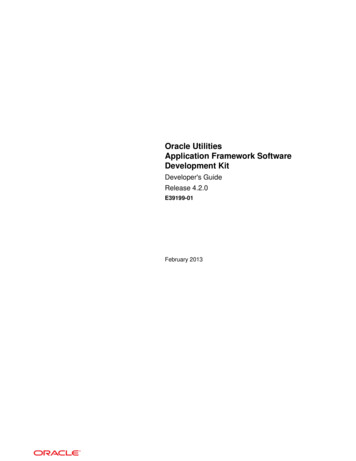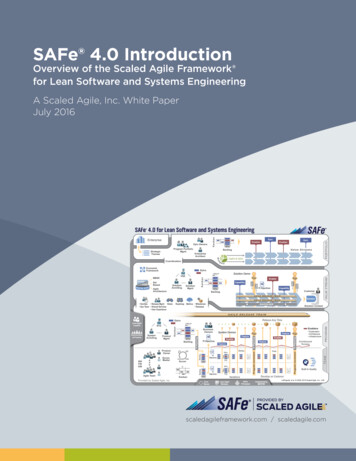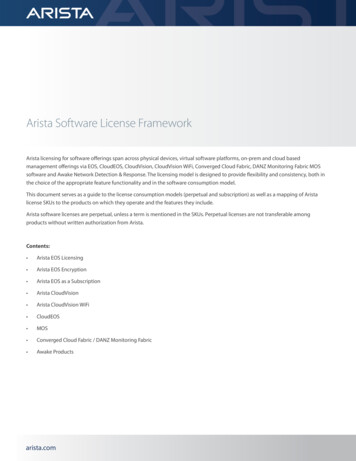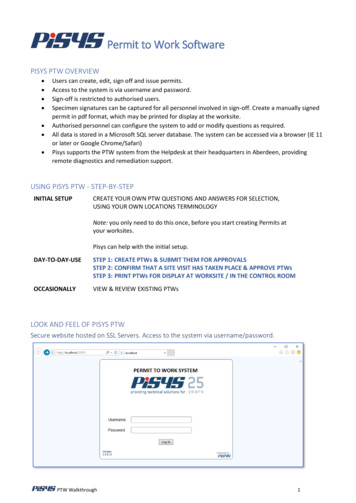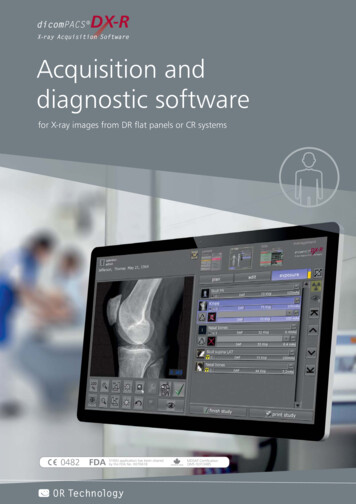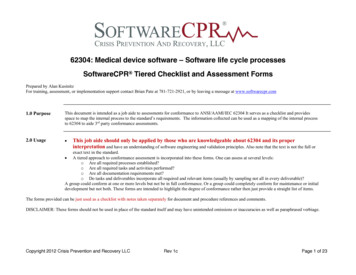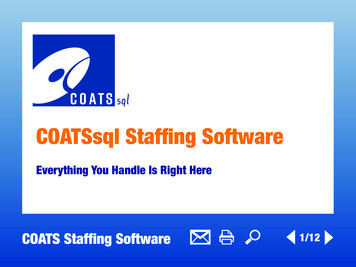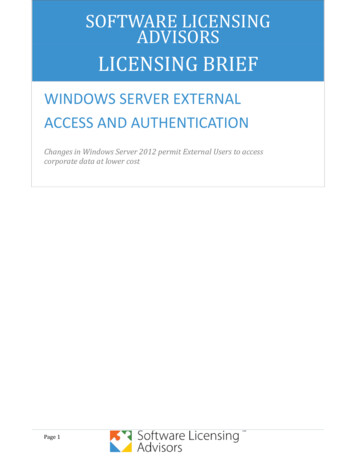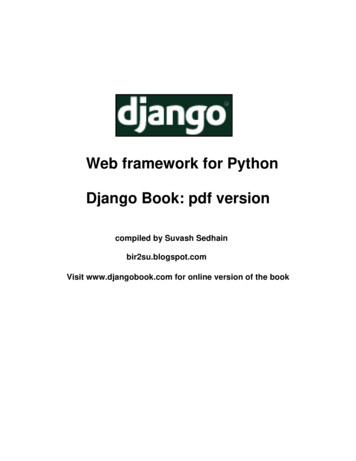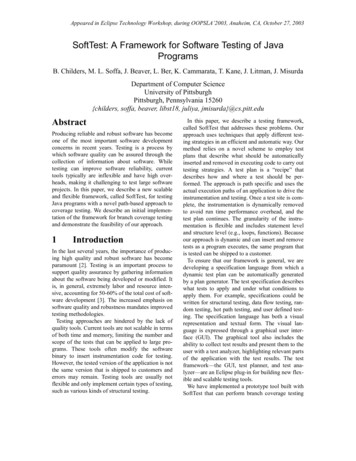
Transcription
Appeared in Eclipse Technology Workshop, during OOPSLA’2003, Anaheim, CA, October 27, 2003SoftTest: A Framework for Software Testing of JavaProgramsB. Childers, M. L. Soffa, J. Beaver, L. Ber, K. Cammarata, T. Kane, J. Litman, J. MisurdaDepartment of Computer ScienceUniversity of PittsburghPittsburgh, Pennsylvania 15260{childers, soffa, beaver, libst18, juliya, jmisurda}@cs.pitt.eduAbstractProducing reliable and robust software has becomeone of the most important software developmentconcerns in recent years. Testing is a process bywhich software quality can be assured through thecollection of information about software. Whiletesting can improve software reliability, currenttools typically are inflexible and have high overheads, making it challenging to test large softwareprojects. In this paper, we describe a new scalableand flexible framework, called SoftTest, for testingJava programs with a novel path-based approach tocoverage testing. We describe an initial implementation of the framework for branch coverage testingand demonstrate the feasibility of our approach.1IntroductionIn the last several years, the importance of producing high quality and robust software has becomeparamount [2]. Testing is an important process tosupport quality assurance by gathering informationabout the software being developed or modified. Itis, in general, extremely labor and resource intensive, accounting for 50-60% of the total cost of software development [3]. The increased emphasis onsoftware quality and robustness mandates improvedtesting methodologies.Testing approaches are hindered by the lack ofquality tools. Current tools are not scalable in termsof both time and memory, limiting the number andscope of the tests that can be applied to large programs. These tools often modify the softwarebinary to insert instrumentation code for testing.However, the tested version of the application is notthe same version that is shipped to customers anderrors may remain. Testing tools are usually notflexible and only implement certain types of testing,such as various kinds of structural testing.In this paper, we describe a testing framework,called SoftTest that addresses these problems. Ourapproach uses techniques that apply different testing strategies in an efficient and automatic way. Ourmethod relies on a novel scheme to employ testplans that describe what should be automaticallyinserted and removed in executing code to carry outtesting strategies. A test plan is a “recipe” thatdescribes how and where a test should be performed. The approach is path specific and uses theactual execution paths of an application to drive theinstrumentation and testing. Once a test site is complete, the instrumentation is dynamically removedto avoid run time performance overhead, and thetest plan continues. The granularity of the instrumentation is flexible and includes statement leveland structure level (e.g., loops, functions). Becauseour approach is dynamic and can insert and removetests as a program executes, the same program thatis tested can be shipped to a customer.To ensure that our framework is general, we aredeveloping a specification language from which adynamic test plan can be automatically generatedby a plan generator. The test specification describeswhat tests to apply and under what conditions toapply them. For example, specifications could bewritten for structural testing, data flow testing, random testing, hot path testing, and user defined testing. The specification language has both a visualrepresentation and textual form. The visual language is expressed through a graphical user interface (GUI). The graphical tool also includes theability to collect test results and present them to theuser with a test analyzer, highlighting relevant partsof the application with the test results. The testframework—the GUI, test planner, and test analyzer—are an Eclipse plug-in for building new flexible and scalable testing tools.We have implemented a prototype tool built withSoftTest that can perform branch coverage testing
Appeared in Eclipse Technology Workshop, during OOPSLA’2003, Anaheim, CA, October 27, 2003Eclipse Plug-inApplicationTest Spec.Test PlannerTest SpecificationJVMTest PlanJikesRVMTest VirtualMachineT1 T2 T3 T4ResultsFigure 1: SoftTest testing framework for Java programsover multiple regions of code in a Java program todemonstrate the feasibility and practicality of ourapproach. Our preliminary results show low runtime overhead for several small Java programs.2Test FrameworkWe are developing SoftTest as a complete framework for testing of Java software. Figure 1 showsthe components in the framework, including a testspecifier, a test planner, a test virtual machine(TVM), and a test analyzer. One component is a language, testspec, for specifying a software test process. The specification includes the relevant parts ofthe program to be tested and the actions needed inthe testing process. Testers can either write a specification in testspec or, better, use the GUI, whichautomatically generates a specification in testspec.A test planner consumes the testspec specificationand determines a plan for testing the program giventhe specification. Using the plan, the TVM dynamically instruments an executing program to conductthe specified tests. Hence, the test plan is essentiallya “program” that runs on the TVM to apply different software tests. The TVM is incorporated in theIBM Jikes Java RVM. Finally, the framework hasan analyzer for reporting test results to the user.In the following sections, we discuss SoftTest andour branch coverage tool, including test specification, test planning, the TVM, and the test analyzer.2.1Test SpecificationIn testing a software application, a developer maywish to apply different tests to various code regions.The tests are also often applied with different cover-age criteria. SoftTest includes a graphical user interface for specifying the tests to apply, where to applythem, and under what conditions. Our tool forbranch coverage testing includes the capability toselect code regions using the GUI interface. A coverage criteria can also be specified for each region.As shown in Figure 2, the GUI lets an user visually create a test specification. The main GUI features are identified with numbers in Figure 2.Feature 1 shows the button within the Eclipse platform that allows Eclipse to start the GUI. Feature 2is the screen where the user creates and runs tests.Feature 3 displays where the user selects the teststo run and defines regions to test. Feature 4 showsthe text selection component of the GUI for highlighting lines of code to test in a Java program. Inthis way, the user is able to see the code and exactlywhat needs to be tested.Features 5 and 6 aid the user in setting parametersfor a specific test. One of these parameters is thenumber of times a code section should be hit to beconsidered covered. Finally, feature 5 sets parameters for whole test specification. From the visualspecification, the GUI generates a specification inthe testspec language. An example of the test specification for a method is shown in Figure 3.As shown, the test specification language represents a user’s desired test process. The languageconsists of two parts: DEFINITIONS and a BODY.In DEFINITIONS, regions of the code to test aredefined. A region consists of a.java file name andclass name, followed by any combination of linenumbers, procedure names, loop identifiers or otherregions. The purpose of DEFINITIONS is to
Appeared in Eclipse Technology Workshop, during OOPSLA’2003, Anaheim, CA, October 27, 2003Figure 2: Test specification in Eclipse GUIdeclare code regions for testing that can be referenced in the BODY section.The BODY section has the actual test specifications. It has the test type (BRANCH TEST meansbranch coverage testing) and what regions fromDEFINITIONS to apply that test. In addition, conditions can be specified that must be met for the testto be considered complete. In Figure 3, the test coverage specified is 90%, meaning the test is completewhen branch coverage reaches 90%.public class simple6 {public int foo(int x) {if (x 200) x x 100;else x x - 100;return x;} }DEFINITIONS {NAME: X, REGION D,LOCATION: FILE example.java {CLASS simple6, METHOD foo}} BODY {DO BRANCH TESTON REGION X UNTIL: 90% }Figure 3: Example test specification2.2Test PlannerFrom the test specification, an intermediate representation is generated for the test planner to decidehow to instrument a Java program. For branch coverage, the test planner is invoked every time amethod is loaded by the Jikes Just-in-Time compiler. The planner checks whether the loadedmethod is in the test specification to see whether itshould be instrumented to apply branch coveragetesting. Thus, only methods that are actually loadedand executed are instrumented by the planner.The planner also retrieves the source code to bytecode line number mapping from a Java class file. Ifa user specified certain test regions, the planner willidentify the basic blocks that need to be tested andset the appropriate parameters in the test plan.The main function of the test planner is to determine where and how to test the application by producing a test plan. A test plan has two parts: a testtable and instrumentation payload. The test tablehas information about how to conduct a specifictest. For branch coverage, it says when to insert andremove instrumentation for covering each edge of amethod’s control flow graph (CFG). The payloadcode is target machine code that is executed at eachinstrumentation point. The payload for branch coverage updates a table that records which edges havebeen covered. The payload also removes instrumentation once an edge has been covered and insertsnew instrumentation to cover edges that are next toexecute and have not yet been hit. In this way, thepayload inserts and removes instrumentationdynamically along a path of execution.To apply branch coverage testing with minimaloverhead, the test planner must determine how bestto instrument the program. The goal is to minimizethe amount of instrumentation that is executed
Appeared in Eclipse Technology Workshop, during OOPSLA’2003, Anaheim, CA, October 27, 2003block 5, we do not know whether the actual predecessor was block 2 or 3 because the instrumentationfor covering block 2 and 3 was removed. To solvethe stranded block case, instrumentation is placed inpredecessors' basic blocks if the above conditionsare satisfied.Finally, the test planner can reduce the instrumentation overhead by inserting specialized payloadsfor single-entry blocks and their predecessors.Since single-entry blocks have a single predecessor,a simplified version of instrumentation can be usedthat updates the coverage table without knowledgeabout predecessor blocks.pro123456epi(a) Example CFG withstranded block (shaded)(b) Example CFG withblock as its own successorFigure 4: Example CFGs for test plannerwhen the method runs. Instrumentation is placeddynamically by having a block that is hit placeinstrumentation in its successors, according to theplan. To determine the edge that was executed forbranch testing, predecessors and successors areneeded. To get this information, the planner constructs a method’s CFG.The CFG is also used to identify special code constructs to identify the best way to instrument them.For instance, a reflexive block is a special case thatoccurs when a basic block has itself as a successor(see Figure 4b). The planner recognizes this condition and ensures that instrumentation is inserted toaccount for the reflexive loop by describing whereits successor should place the instrumentation.Other cases arise when there may not be enoughinformation to determine which edge was taken bya branch. To produce correct branch coverageresults, it is necessary to track of the current block'spredecessor at run-time, so that the appropriateedge can be marked as covered. One special caseoccurs for a stranded basic block. Assume a basicblock A has multiple predecessors and at least oneof A’s predecessors has multiple children. Thencontrol comes from any predecessor but the first,we must ensure that there is instrumentation in thepredecessor so the edge can be identified. In Figure4a, the shaded block (5) is stranded if the paths 1 2- 4- 6 and 1 3 5 6 are taken and then the path1- 2- 5- 6 is taken. However, since instrumentation is inserted and deleted dynamically in ourscheme, instrumentation would be removed fromblocks 2 and 3 as soon as instrumentation is put inits successors (4 and 5). In the second time through2.3Test Virtual MachineUsing the information gathered from the test planner, the TVM provides the functionality to insertand remove instrumentation at run-time. The TVMoperates on target machine code generated by theJikes JIT compiler. The TVM implements an interface for inserting and removing instrumentationwith fast breakpoints. A fast breakpoint replaces aninstruction in the target machine code with a jumpto a breakpoint handler that invokes the test instrumentation payload from the test planner.In the prototype for branch coverage, the TVMinserts a breakpoint in the first point specified bythe test plan. This single breakpoint is then responsible for placing the next breakpoints needed,which, in the case of branch coverage, would be thenodes as identified by the planner as successor basicblocks. These successor breakpoints in turn, as theyare hit, execute payload code that is responsible forplacing breakpoints in successor blocks. In thismanner, we can minimally affect the execution ofthe program since we are guiding the instrumentation by the currently executing path. This allows forperformance to be minimally affected since hotpaths and tight loops will be instrumented only for afew passes. Hence, most of the execution time isspent executing code without instrumentation.The TVM’s API provides primitives, such as theplacement of successor breakpoints, storing testspecific data, and removal of breakpoints, for constructing fast breakpoints with varying payloads.This API allows for flexible instrumentation thatcan be specified in a variety of ways. The instrumentation constructed with the API is also highlyscalable since only relevant portions of the programare instrumented for only as long as needed.
Appeared in Eclipse Technology Workshop, during OOPSLA’2003, Anaheim, CA, October 27, 20032.4Test AnalyzerThe test analyzer displays the results of tests conducted in the SoftTest framework. For branch coverage, the analyzer displays the CFG for a methodand highlights the edges that were covered for aparticular test input. The prototype displays theCFG for the target machine code; we are implementing support for source level coverage as well.3Preliminary ResultsOur branch coverage tool implements the methodology outlined in this paper. A user can specifycode regions on which to apply branch coverage forarbitrary methods in a Java program.Using our tool, we have done preliminary experiments to determine performance and memory overhead. The benchmarks are small Java programs thatuncompress a file, transpose a matrix, and createparallel threads. On these programs, the performance overhead for coverage varied from 1% to5.5% of the total execution time. Of the total performance overhead, the test planner accounted for27% to 64% and the instrumentation code 36% to72%. In some cases, the planner overhead was morethan the instrumentation overhead. This case canoccur when a method has many basic blocks, but ashort path is taken through the method. Similarly,the instrumentation overhead can be higher than theplanning overhead when some instrumentation isrepeatedly hit (e.g., in a stranded block in a loop).For the benchmarks, the memory overhead was178 to 822 bytes for the test table. The payload codehas a common portion that is shared by all instrumentation points and a portion specific to eachbreakpoint inserted. The common code is 110 bytesand the breakpoint specific code is 31 bytes.These initial experiments demonstrate that ourapproach has both low performance and memoryoverhead. We are currently evaluating the overheadfor larger programs, including the SPECjvm98benchmarks, and we expect that our preliminaryresults will scale to these programs.4Related WorkThere are a number of commercial tools that perform coverage testing on Java programs, includingJCover and IBM’s Rational TestStudio. Most ofthese tools statically instrument the program to per-form coverage testing. The work that is mostclosely related to ours is a tool developed with theParaDyn parallel instrumentation framework [4].This tool dynamically inserts and removes instrumentation on method invocations to do node coverage, where we take a similar approach for branchcoverage. Unlike our approach, instrumentation isinserted in the whole method when it is invoked anda separate garbage collection process is done toremove instrumentation. Our technique instruments only along executed paths and removesinstrumentation on-demand as soon as possible.5SummaryThis paper described a framework, called SoftTest,for software testing of Java programs that relies ona novel scheme for dynamically inserting andremoving instrumentation based on executionpaths. We presented an initial prototype tool builtwith SoftTest for branch coverage testing. Our preliminary results are very encouraging: The testoverhead on several small benchmarks ranged from1% to 5.5%. We are currently extending our framework and tools to support other test types, includingstatement coverage and def-use coverage. Ourfuture work will also include the ability to conductsoftware tests on optimized Java code.AcknowledgementsThis research was supported in part by an IBMEclipse Innovation Grant.References[1] P. Kessler, “Fast breakpoints: Design andimplementation”, ACM SIGPLAN Conf. onProgramming Languages, Design and Implementation, June 1990.[2] L. Osterweil et al., “Strategic directions in software quality”, ACM Computing Surveys, Vol.4, December 1996.[3] W. Perry, Effective Methods for Software Testing, John Wiley & Sons, Inc., New York, NewYork, 1995.[4] M. Tikir and J. Hollingsworth, “Efficientinstrumentation for code coverage testing”,Int’l. Symp. on Software Testing and Analysis,Rome, Italy, 2002.
Appeared in Eclipse Technology Workshop, during OOPSLA’2003, Anaheim, CA, October 27, 2003 Abstract Producing reliable and robust software has become one of the most important software development concerns in recent years. Testing is a process by which software quality can be assured th

